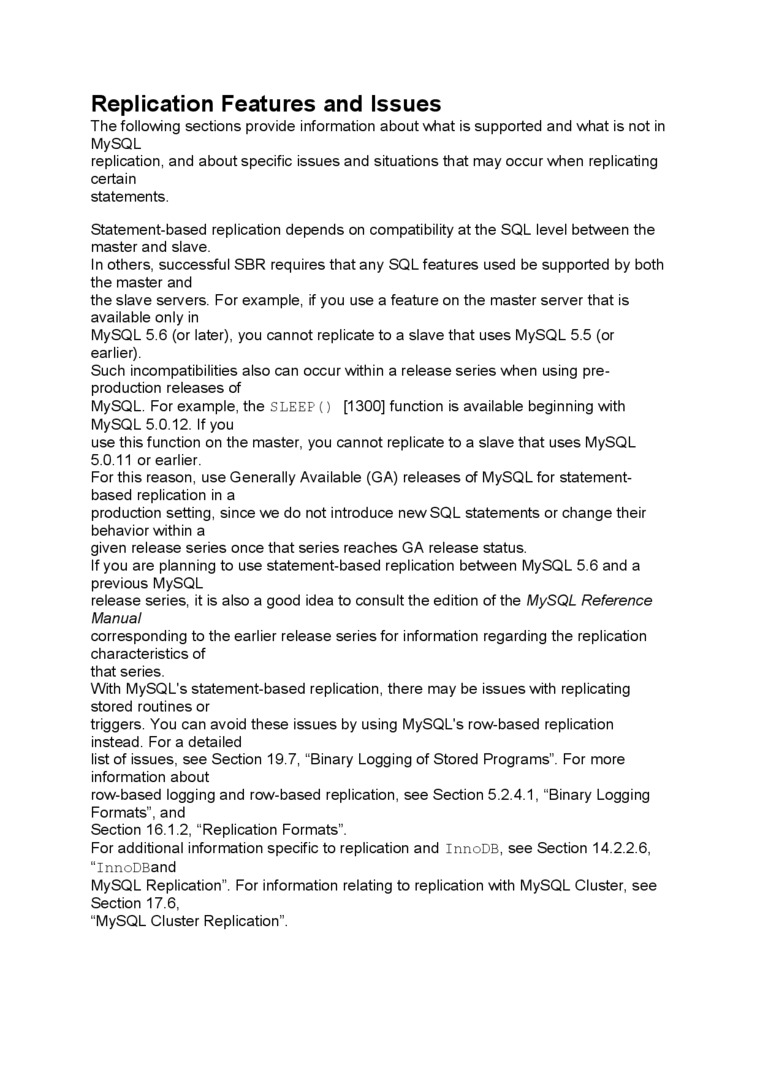89479

Replication Features and Issues
The following sections provide information about what is supported and what is not in MySQL
replication, and about specific issues and situations that may occur when replicating
certain
State ments.
State me nt-based replication depends on compatibility atthe SQL level between the master and slave.
In others, successful SBR requires that any SQL features used be supported by both the master and
the slave servers. For example, if you use a feature on the master server that is available only in
MySQL 5.6 (or later), you cannot replicate to a slave that uses MySQL 5.5 (or earlier).
Such incompatibilities also can occur within a release series when using pre-production releases of
MySQL. For example, the SLEEP () [1300] function is available beginning with MySQL 5.0.12. Ifyou
use this function on the master, you cannot replicate to a slave that uses MySQL 5.0.11 or earlier.
For this reason, use Generally Available (GA) releases of MySQL for statement-based replication in a
production setting, sińce we do not introduce newSQL statements or change their behavior within a
given release series once that series reaches GA release status.
If you are planning to use statement-based replication between MySQL 5.6 and a previous MySQL
release series, it is also a good idea to consult the edition of the MySQL Reference Manuał
corresponding to the earlier release series for information regarding the replication characteristics of that series.
With MySQL's statement-based replication, there may be issues with replicating stored routines or
triggers. You can avoid these issues by using MySQL's row-based replication instead. For a detailed
list of issues, see Section 19.7, “Binary Logging of Stored Programs". For morę information about
row-based logging and row-based replication, see Section 5.2.4.1, "Binary Logging Formats", and
Section 16.1.2, "Replication Formats".
For additional information specific to replication and innoDB, see Section 14.2.2.6,
“InnoDBand
MySQL Replication". For information relating to replication with MySQL Cluster, see Section 17.6,
“MySQL Cluster Replication".
Wyszukiwarka
Podobne podstrony:
MySQL Cluster Data Node Configuration Parameters The summary table in this section provides informat
Installing MySQL on FreeBSD This section provides information about installing MySQL on variantsof F
Building MySQL Cluster from Source on Linux This section provides information about compiling MySQL
2.2 Terminology and Nomenclature The following section is dedicated to explanations of the terminolo
Obraz0009 (2) I Identify the following excerpts (provide tlie title, the nanie of the author - when
41844 Obraz0009 (2) I Identify the following excerpts (provide tlie title, the nanie of the author -
Obraz0003 (3) I Identify the following excerpts (provide the title, the name of the author - when ap
Obraz0003 (3) I Identify the following excerpts (provide the title, the name of the author - when ap
Obraz0009 (2) I Identify the following excerpts (provide tlie title, the nanie of the author - when
SettingsFoldersand File Types Transferred by Default The following sections deseribe the files, fold
S6301998 f Fili in the following sections <removtng comment marłeś f łf necessartf. and delete th
41844 Obraz0009 (2) I Identify the following excerpts (provide tlie title, the nanie of the author -
Obraz0003 (3) I Identify the following excerpts (provide the title, the name of the author - when ap
Obraz0010 (2) uU ] Identify the following excerpts (provide the title, the literary period to which
Replication and Binary Logging Options and Variables The next fewsections contain information about
Median simple 7 Median The following section describes the procedurę to be foliowe d, using the data
Host Na mes Host names are used in virtually all TCP/IP environments. The following list provides a
więcej podobnych podstron